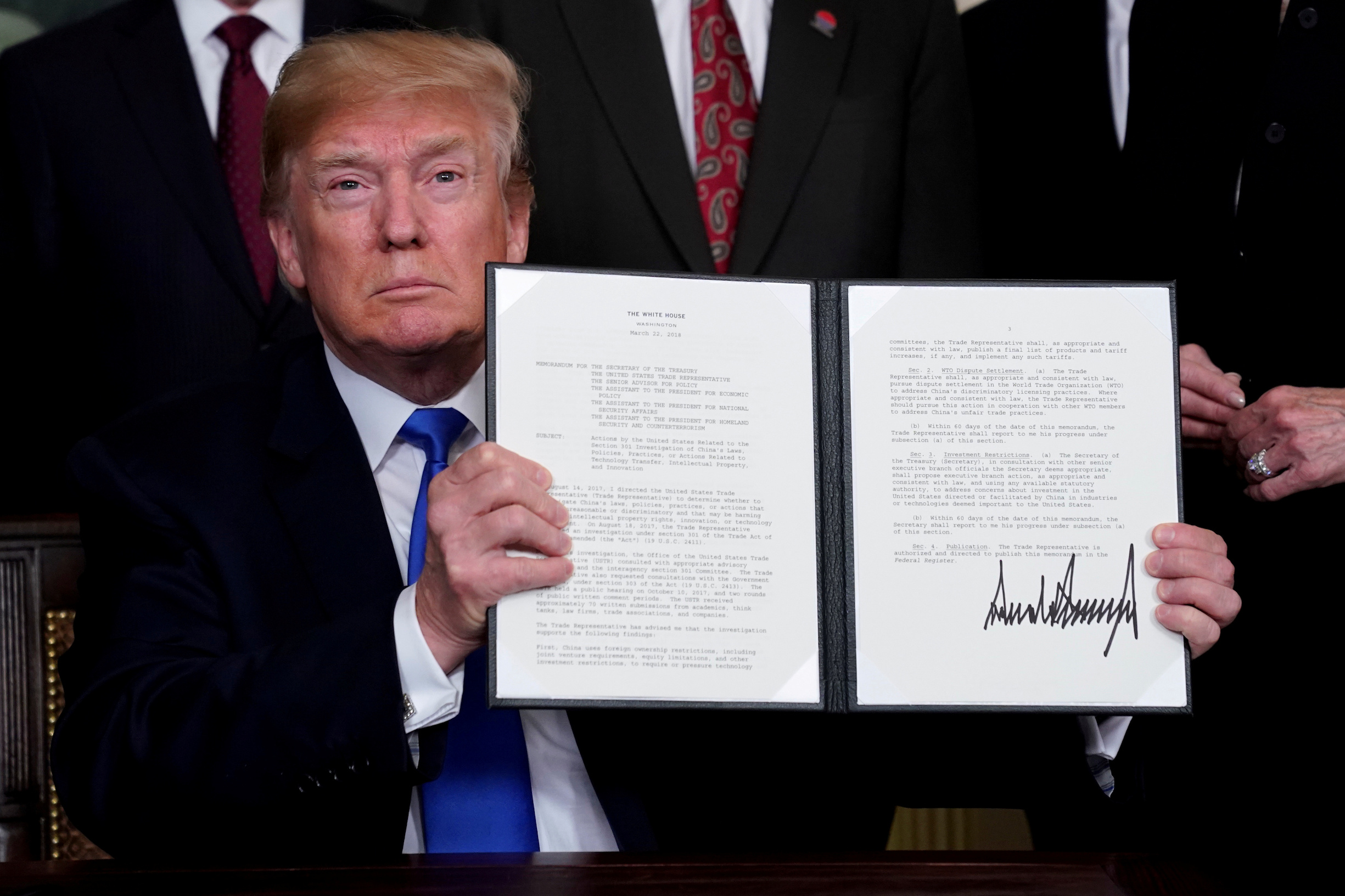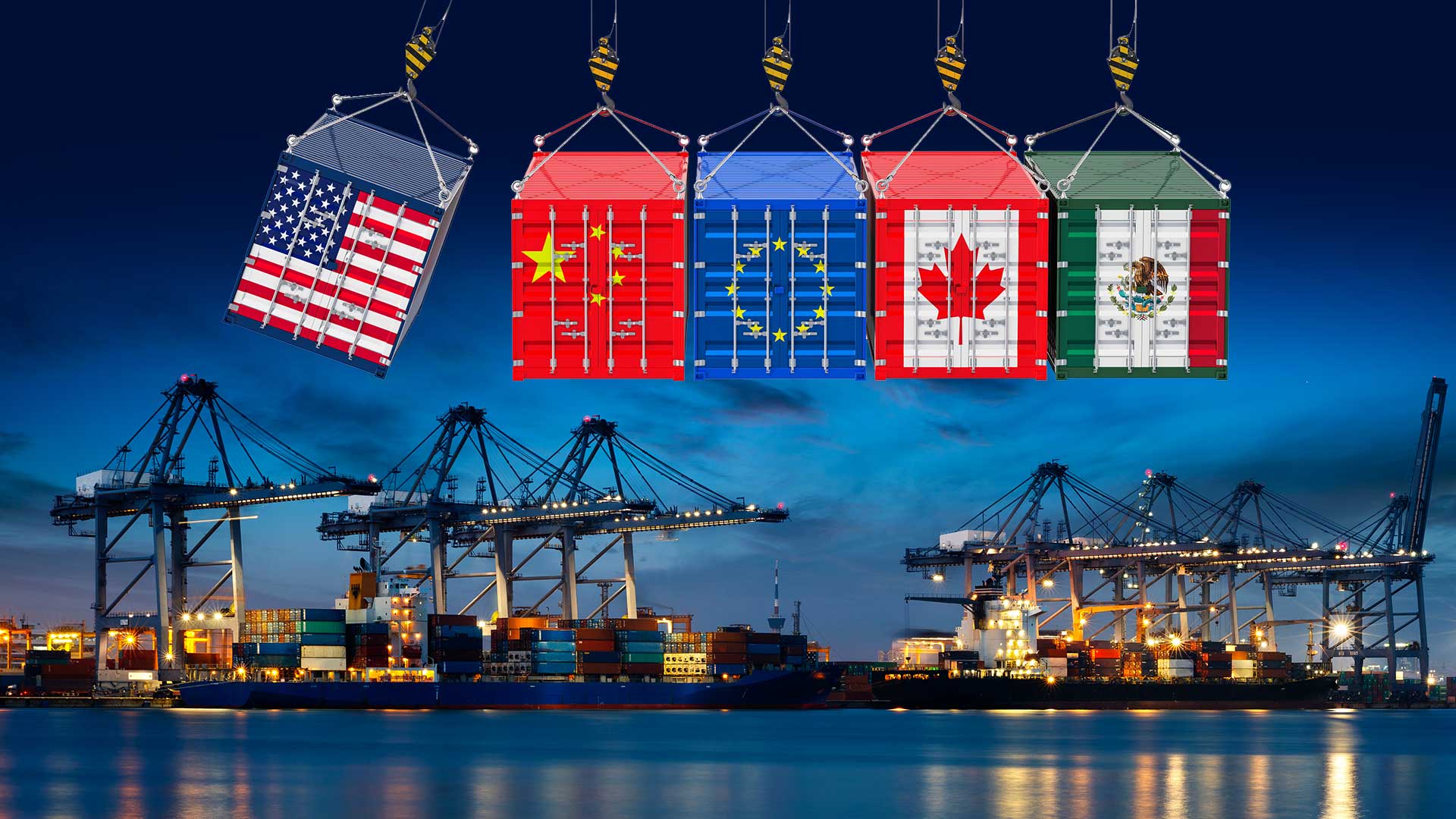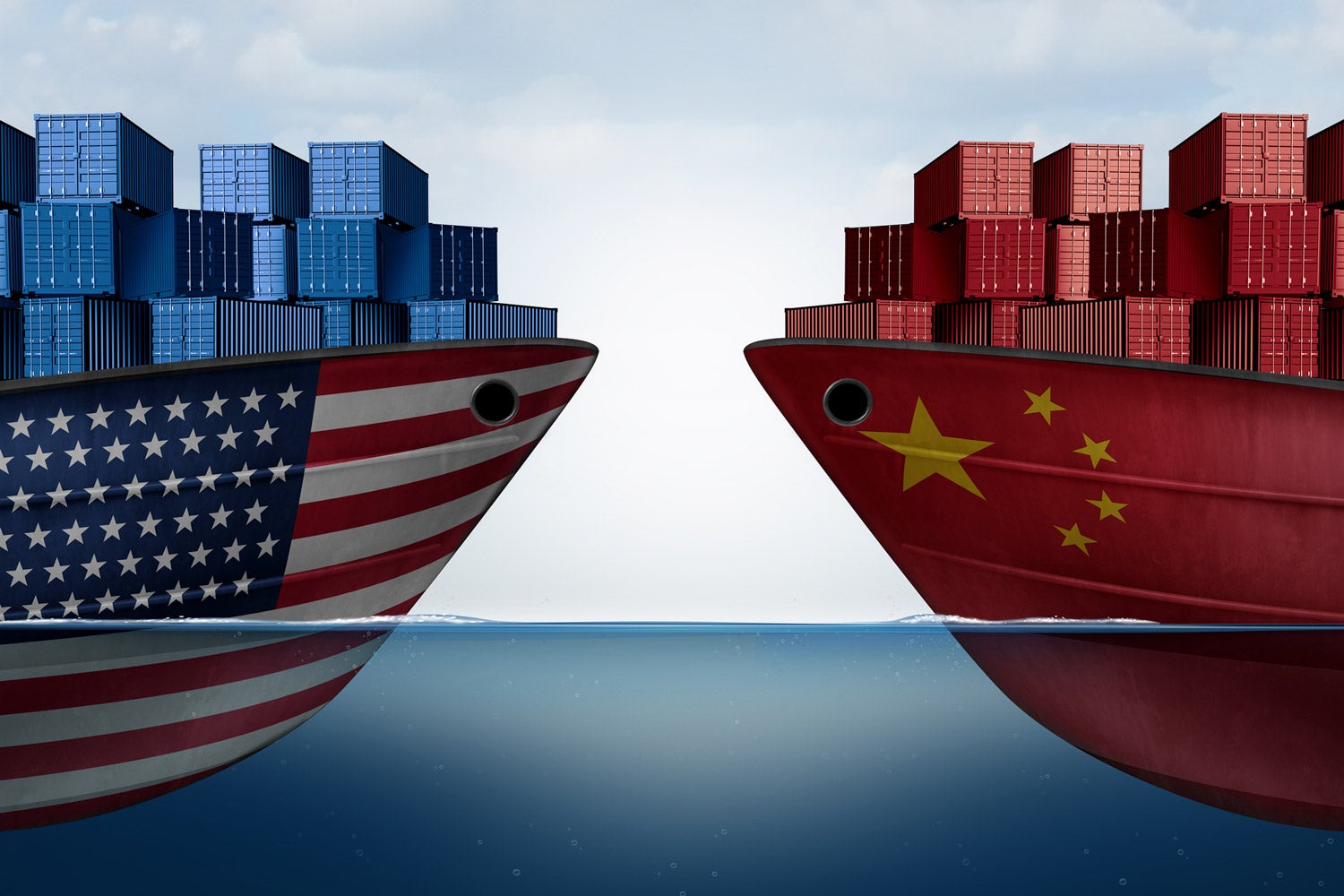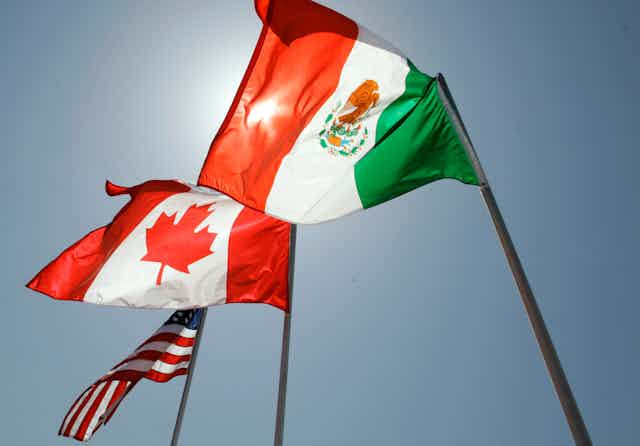Economy
And The Trade Wars Begin…Disruptions Ahead! Trump’s Promise Of Tariffs Against Mexico, Canada, And China Comes To Fruition, But Not Without Retaliation. Multifold Economies to Be Affected
Published
10 months agoon

Trade wars are on the horizon even as global economies are bracing for turmoil as U.S. President Donald Trump follows through on his controversial promise to impose hefty tariffs on imports from Canada, Mexico, and China. The move, which has already sparked immediate retaliation from affected nations, is expected to fuel tensions and disrupt trade flows in multiple industries.
Trump’s Tariff Strike
True to his pledge, President Trump, on Saturday, ordered the imposition of 25% tariffs on Canadian and Mexican imports and 10% on goods from China, effective Tuesday. He has vowed to keep these tariffs in place until the United States’ national emergency over fentanyl trafficking and illegal immigration is resolved.
While energy products from Canada will face a relatively lower duty of 10%, Mexico’s energy exports to the U.S. will be subjected to the full 25% levy. Trump has invoked the International Emergency Economic Powers Act and the National Emergencies Act to justify these sweeping tariffs, granting him broad authority to impose economic sanctions under crisis conditions.
The official implementation will begin at 12:01 a.m. EST (0501 GMT) on Tuesday, as per Trump’s written directive. However, goods already in transit before 12:01 a.m. on Saturday will be exempt from these new duties.
Mexico’s Counteraction
In response, Mexican President Claudia Sheinbaum has swiftly directed her economy minister to introduce retaliatory tariff and non-tariff measures against U.S. imports. Mexico, which has intensified its crackdown on organized crime and fentanyl smuggling, sees Trump’s actions as unjust and counterproductive.
Under Sheinbaum’s leadership, Mexico has seized approximately 20 million doses of synthetic opioid fentanyl and arrested over 10,000 individuals involved in drug trafficking. Despite these efforts, Trump has blamed Mexico for failing to curb the flow of fentanyl into the U.S. and for allowing unchecked migration across the southern border.
Taking to social media, Sheinbaum emphasized that Mexico does not seek conflict with its northern neighbor but will continue to prioritize diplomatic engagement and constructive negotiations. Her administration remains committed to de-escalating tensions while defending Mexico’s economic interests.
Canada’s Retaliation
The Canadian government has announced countermeasures, imposing 25% tariffs on $155 billion worth of U.S. goods in response to what it calls “unjustified and unreasonable” tariffs on Canadian exports.
The first phase of Canada’s counteraction, set to take effect on February 4, 2025, will introduce tariffs on $30 billion worth of U.S. imports, including orange juice, peanut butter, wine, spirits, beer, coffee, appliances, apparel, footwear, motorcycles, cosmetics, and pulp and paper. A detailed list of affected goods will be released shortly.
Additionally, Minister Dominic LeBlanc revealed plans for a second wave of tariffs targeting an additional $125 billion worth of U.S. imports, subject to a 21-day public consultation. This phase will likely impact key American exports such as passenger vehicles (including electric cars), steel and aluminum products, aerospace components, beef, pork, dairy, and recreational vehicles.
Canadian officials have vowed to explore all available countermeasures, including non-tariff restrictions, should the U.S. persist with its aggressive tariff strategy.
Citing hard data, Canada has pushed back against the justification for these tariffs, pointing out that less than 1% of fentanyl entering the U.S. originates from Canada. In a strongly worded statement, the Canadian government declared its refusal to “stand idly by” while being unfairly targeted, promising unwavering support for affected workers and businesses.
Quick Facts. U.S.-Canada Trade
Canada is the largest buyer of U.S. goods and services, purchasing more than China, Japan, France, and the U.K. combined. Trade between the two countries is critical, supporting millions of jobs on both sides of the border. Every day, over $2.5 billion worth of goods and services flows between the U.S. and Canada, making it one of the most significant trade relationships in the world.
For 36 U.S. states, Canada is the largest export market, while for 46 states, it ranks among the top three. In fact, 43 states export over $1 billion to Canada annually. Despite tensions, the U.S. maintains a $33 billion trade surplus in manufacturing with Canada as of 2023, making it the only one of America’s top five trading partners with whom it enjoys such an advantage.
China’s Response
China’s Ministry of Commerce hit back, claiming that the new tariffs “seriously violate” World Trade Organization rules. They’ve announced plans to file a complaint with the WTO and take countermeasures to “resolutely defend its rights.” What those measures might be, though, remains unclear.
Meanwhile, China’s Ministry of Foreign Affairs also weighed in, calling the tariffs “not constructive” and arguing that they would only “undermine” efforts from both nations to tackle the narcotics issue. They pointed out that China has been supportive of the U.S. on the fentanyl front but emphasized, “fentanyl is America’s problem.”

Trump Faces Backlash
On the U.S. side, business groups and corporations were not happy about the new tariffs.
The U.S. Chamber of Commerce slammed the move, warning that it will raise consumer prices.
In a statement, the group acknowledged that Trump was right to focus on securing the border and addressing the fentanyl problem. But, they said, using tariffs under IEEPA (International Emergency Economic Powers Act) is unprecedented and won’t solve the issue. Instead, it will hike prices for American families and disrupt supply chains.
John Murphy, the Chamber’s senior vice president said, “We’ll be consulting with our members, including small businesses, to figure out the next steps to avoid harming the U.S. economy.”
The Distilled Spirits Council of the U.S., the Mexican Chamber of the Tequila Industry, and Spirits Canada also voiced concerns. They stated that the tariffs on spirits from Canada and Mexico could significantly harm all three countries. Last year, the U.S. imported $46 billion in agricultural products from Mexico, including $8.3 billion worth of fresh vegetables, $5.9 billion in beer, and $5 billion in distilled spirits.
The energy sector also expressed dissatisfaction with the reduced tariffs on Canadian oil, gas, and electricity. The American Petroleum Institute (API), which represents Big Oil, said it wanted complete exclusions from the tariffs, warning that fuel prices would rise on the $14.4 billion worth of oil and natural gas imported annually from Canada.
API CEO Mike Sommers stated, “We’ll keep working with the Trump administration to ensure energy affordability for consumers and support U.S. jobs.”
NEMA, representing the electricity industry, urged a more cautious approach, stressing that the electricity and electronics sectors are major players in both U.S. imports and exports.
Farmers, represented by Western Growers, warned that the tariffs would negatively impact U.S. food producers. “While we understand the administration’s focus on border security, growers outside the U.S. will quickly seize the new opportunities these tariffs create to sell into Canadian, Mexican, and Chinese markets,” said CEO Dave Puglia.
Consumer groups also cautioned that Trump’s tariffs would drive up costs for Americans. “Tariffs are essentially a tax hike on U.S. households and manufacturers,” said Pete Sepp, president of the National Taxpayers Union

Why These Countries?
Mexico, China, and Canada are the top three trading partners of the United States.
In 2023, Mexico surpassed China as the leading exporter of goods to the U.S., making it the first time in two decades that China was no longer the number one exporter. The tariffs imposed during the first Trump administration, which the Biden administration largely kept in place, have decreased the amount of goods the U.S. imports from China. On the other hand, Mexican and Canadian goods have been imported into the U.S. almost duty-free, thanks to the United States-Mexico-Canada Agreement (USMCA), which Trump negotiated during his first term.
Mexico held onto that top spot in 2023, exporting $467 billion worth of goods to the U.S., followed by China with $401 billion and Canada at $377 billion. These figures are based on Commerce Department data through November of last year, the latest available. Together, these three countries made up 42% of the nearly $3 trillion worth of goods the U.S. imported globally in 2023.
When it comes to U.S. exports, Canada leads the way, receiving $322 billion in goods, followed by Mexico with $309 billion and China at $131 billion. Exports to these three nations accounted for over 40% of the $1.9 trillion worth of goods the U.S. exported globally last year.
With such high trade volumes, any changes, like tariffs, could drive up costs for Americans across a variety of products.
For example, last year, the U.S. imported $87 billion worth of motor vehicles and $64 billion worth of vehicle parts from Mexico. These prices are likely to rise almost immediately if new tariffs are applied to Mexican car exports to the U.S. The auto industry has long operated as if the U.S., Canada, and Mexico were one unified market, with cars and parts freely crossing borders for assembly. Even cars made in U.S. plants rely on parts from Mexico and Canada, and vice versa.
In the steel sector, Canada now accounts for nearly a quarter of the steel imported by U.S. businesses, and Mexico accounts for about 12%, according to data from the American Iron and Steel Institute.
Other key imports from these countries—like gas, fresh produce, and consumer electronics—could also become more expensive if blanket tariffs are introduced.
The economic fallout of Trump’s tariff plan is expected to be severe. According to EY Chief Economist Greg Daco, the tariffs could slash U.S. economic growth by 1.5 percentage points, drive Canada and Mexico into recession, and usher in stagflation—a combination of slow growth and high inflation—in the U.S.

How Trade Wars Will Impact These Countries and the World
Trade wars, particularly those between the U.S., China, Mexico, and Canada, are far more than just political squabbles; they can significantly disrupt economies, supply chains, and global markets. The consequences ripple outward, affecting not only the countries directly involved but also other nations and global markets at large.
Here’s an in-depth look at how these trade wars might unfold and the far-reaching effects they could have.
1. Impact on the United States
The U.S. is at the heart of this trade conflict, and its economy will undoubtedly face numerous challenges, both short-term and long-term, depending on how tariffs and trade restrictions are implemented.
Increased Consumer Prices
One of the most immediate effects of these trade wars will be higher prices for consumers. Tariffs on imported goods—especially from countries like Mexico, Canada, and China—will increase the cost of everything from electronics to food.
Goods that are typically imported into the U.S. at low or zero tariffs, such as motor vehicles, vehicle parts, fresh produce, and steel, could see a sharp price hike. As a result, American consumers will feel the pinch, with everyday items becoming more expensive. For instance, the U.S. imported billions of dollars worth of cars and vehicle parts from Mexico, and any tariffs on these imports would make cars and trucks more expensive for consumers.
Supply Chain Disruptions
The U.S. economy is tightly interconnected with its neighbors and China, especially in manufacturing. Many industries in the U.S. have relied on a smooth flow of parts and raw materials from Mexico, Canada, and China.
A trade war could cause severe disruptions to this interconnected supply chain, leading to production delays, shortages of raw materials, and higher operational costs for manufacturers. The auto industry, in particular, could be severely affected, as parts and materials are often sourced from both sides of the border. Even vehicles assembled in the U.S. use parts that come from Mexico and Canada. Increased tariffs or trade restrictions could lead to supply bottlenecks, disrupting production timelines and ultimately harming American businesses and workers.
Economic Slowdown and Job Losses
As higher prices lead to reduced consumer spending, U.S. businesses may suffer from a slowdown in demand. Retailers and manufacturers might have to cut costs by laying off workers, leading to job losses across various sectors. Certain industries that heavily rely on imports could face even more severe challenges, potentially leading to a full-blown recession.
The unemployment rate could rise as businesses scale back operations or close entirely due to increased production costs. Furthermore, with trade wars disrupting global supply chains, U.S. companies that operate in global markets might lose out on international customers, affecting overall economic growth.
Long-Term Global Economic Isolation
The more the U.S. imposes tariffs, the more it risks isolating itself economically. If other countries follow suit, the world could move away from a globalized, interconnected trade system toward a more fragmented, protectionist global economy. The U.S. may also lose access to essential markets for its exports. With countries like China and Mexico likely retaliating, the U.S. could see its own exports restricted, which would hurt American businesses that rely on international markets.

2. Impact on China
China, being one of the largest exporters to the U.S., is directly impacted by the trade war. The tariffs imposed by the U.S. on Chinese goods have already caused a notable decline in exports, and further restrictions could worsen the situation.
Slowdown in Economic Growth
China’s economy relies heavily on exports to the U.S. and other countries. The trade war will likely contribute to a slowdown in China’s GDP growth as its manufacturing and export industries take a hit. With reduced demand for Chinese goods abroad, Chinese factories could face lower production volumes, leading to layoffs and a reduction in the availability of jobs. Additionally, tariffs on Chinese goods could hurt the profits of Chinese businesses, affecting the country’s financial stability.
Shift Toward Domestic Consumption
As a result of the trade war, China may need to shift its focus from exports to domestic consumption. While this may reduce the reliance on foreign markets in the long term, the transition won’t be easy. China would need to ramp up its internal demand for goods and services, which could take years to fully implement. The country’s manufacturing sectors might struggle during this adjustment period, especially if the global economy also slows down due to the ripple effects of tariffs.
Diversification of Trade Partners
China is already exploring new trade partnerships with countries outside the U.S. to reduce its reliance on the American market. The Belt and Road Initiative (BRI) is one such strategy to expand its economic influence globally. China has increasingly focused on diversifying its trading relationships with countries in Europe, Africa, and Southeast Asia. However, the shift away from U.S. trade might not be enough to cushion the blow from U.S. tariffs in the short term.
Retaliation and Escalating Tensions
China is also likely to retaliate with its own tariffs on U.S. goods. This escalation could further damage the global trade environment, as both countries increase barriers to trade and raise the stakes of their economic rivalry. In addition, the longer the trade war drags on, the greater the risk that China may seek to weaken the U.S. dollar or try to divert its currency reserves, further intensifying the economic standoff.

3. Impact on Mexico and Canada
Both Mexico and Canada, as the U.S.’s closest neighbors, will also feel the effects of these trade wars, albeit in slightly different ways.
Tariffs on Key Exports
Mexico is particularly vulnerable to tariffs on automotive exports. The U.S. is the primary market for Mexican vehicles and vehicle parts, and any increase in tariffs could immediately drive up the cost of these products in the U.S., resulting in lower demand. Similarly, Canadian exports of steel to the U.S. could be affected, leading to reduced revenue for Canadian businesses that rely on U.S. markets.
Both countries also depend heavily on agricultural exports to the U.S., with Mexico sending billions of dollars worth of fresh produce and other agricultural products. Tariffs on these goods could increase food prices in the U.S. and disrupt the trade flow. Mexico also exports a significant amount of beer and spirits to the U.S., and tariff hikes could harm these industries, reducing overall profits.
Job Losses and Economic Instability
Higher tariffs would likely lead to job losses in key sectors, particularly in manufacturing and agriculture. Both Mexico and Canada could see an increase in unemployment as industries reliant on U.S. trade face cutbacks or closures. The overall economic instability caused by trade disruptions could also affect the financial markets and currency exchange rates in both countries.
Rebalancing Trade Relations
To minimize the impact of U.S. tariffs, Mexico and Canada may turn to other international markets for trade. Both countries are likely to seek closer trade ties with other countries in Asia, Europe, and South America. However, this pivot could take time to implement, and there’s no guarantee that it will fully offset the losses from decreased U.S. trade.

4. Global Impact
The U.S.-China trade war, in particular, has a far-reaching effect on the global economy. If the conflict intensifies, the following impacts could be felt worldwide –
Global Recession Risks
A prolonged trade war between the U.S. and China could trigger a global recession. As major economies like the U.S., China, and the EU face economic slowdowns, global markets would see a ripple effect, potentially reducing international trade volumes. Developing economies that rely on exports could be especially hard-hit, as reduced demand for goods from major economies could drive down production levels and economic growth.
Supply Chain Disruptions
Global supply chains are highly interconnected, and tariffs on goods will likely cause significant disruptions. From electronics to agriculture, industries around the world that rely on international trade could be impacted. The cost of production for many goods will increase, pushing companies to either absorb the cost or pass it on to consumers.
Shift Toward Protectionism
If these trade wars continue to escalate, countries around the world may begin embracing protectionist policies. While the rise of protectionism may offer short-term benefits to some industries, it could lead to long-term negative effects, such as reduced global competition, lower-quality goods, and rising prices.
Emerging Market Struggles
Emerging economies that rely on exports could be severely impacted by a global slowdown in trade. These nations could see a reduction in foreign investment, job losses, and inflationary pressures as prices for basic goods rise. Countries in Africa, Asia, and Latin America may particularly suffer as demand for their exports drops and foreign investment dries up.
The Last Bit
The effects of a trade wars between these countries are far-reaching and complex.
While the U.S., China, Mexico, and Canada will be directly impacted, the consequences of these trade tensions will be felt across the globe, potentially triggering a global economic slowdown, disrupting supply chains, and prompting a shift toward protectionism that could harm growth and stability in both developed and emerging markets.
Canadian officials warn that these measures could severely impact American consumers, leading to increased costs at gas stations and grocery stores, job losses in critical sectors, and disruptions in supply chains, particularly in the auto and energy industries.
You may like
-


Taiwan’s ‘Historic’ TSMC Deal, A Win Or The End Of Its ‘Silicon Shield’ As China Threatens? A Jittery Taiwan Watches Trump’s Moves On Ukraine, Wondering, Could We Be Next?
-


A Trade War That Just Won’t Quit. As Trump’s Tariffs Hit, China Stays The Course, For Xi’s Its Business As Usual Strategy
-


Indian Stock Market In Turmoil. Investors In Panic Mode, Is This A Temporary Correction Or The Start Of A Bear Market?
-


America And China’s Thirst For Gold In 2025 Is Draining Other Countries’ Reserves; Here’s Why?
-


Shakeup In The Auto Sector. Mercedes-Benz 15% Job Cuts, Nissan CEO Exit, And Germany’s Make-Or-Break Year
-


DeepSeek Ai Rush. China’s AI Contender Gears Up for Next Big Launch Even As It Gets Xi Jinping’s Blessings
